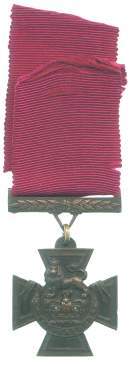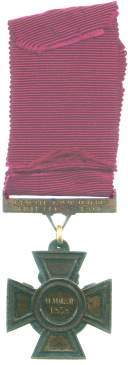Current Location: In storage
Maker(s)
Artist:
Hancock, Charles
Die-engraver:
Hancock, Charles
Ruler:
Victoria (1837-1901)
(Inferred)
Mint:
London
Entities
Categories
Description
The Victoria Cross is the highest award for gallantry that can be made by the United Kingdom. Instituted in 1856 to recognise deeds done in the Crimean War, reportedly at the suggestion of Prince Albert, the new medal was to be given "for valour". Even today this simple statement justifies the medal's award. The first medals were legendarily struck from bronze from the captured Russian guns of Sebastopol, although it is now believed that the metal came from older Chinese cannon that were found in the Arsenal in 1857. (These weapons may however have been captured from the Russians during the Crimean campaign.) The design was entrusted to the London jewellers' firm of C. F. Hancock & Sons, Holborn, and it is there that the Victoria Cross is still made when it is awarded today.
This Cross was awarded to Private David Hawkes, of the 2nd Battalion of the Rifle Brigade (The Prince Consort's Own). David Hawkes (1822-58) was 35 years old during the Indian Mutiny (which is described more fully elsewhere) when the deed took place for which he was awarded the VC. On 11 March 1858 at Lucknow, India (one of the towns which most immediately bore the brunt of the uprising and had to endure a long siege), Private Hawkes's company was engaged with a large number of the enemy near the Iron Bridge. At one stage a captain (Henry Wilmot) found himself at the end of a street with only four of his men, opposed to a considerable body of the enemy. One of the men was shot through both legs and Private Hawkes, although severely wounded, lifted him up with the help of a corporal (William Nash) and they then carried their comrade for a considerable distance, the captain firing with the men's rifles and covering the retreat of the party.
Hawkes's luck did not last; he was killed in action at Fyzabad, India on 14 August 1858. Lester Watson purchased his Cross at some point before 1928.
Notes
History note: Gift of L. Hoyt Watson; ex Lester Watson Collection, bt before 1928
Legal notes
Given by Lester Watson through Cambridge in America, 2009
Measurements and weight
Diameter: 36.8 mm
Weight: 27.96 g
Acquisition and important dates
Method of acquisition: Given
(2009)
by
Watson, Lester
Dating
1858
CE
-
1928
CE
Components of the work
Ribbon
composed of
textile
( dark red silk(?))
Medal
composed of
bronze
Techniques used in production
Struck
Inscription or legends present
Inscription present: Lion standing over crown with inscription on banner below, on cross
- Text: FOR VALOUR
- Location: Obverse
- Type: Design
Inscription present: Inscription in double ring on cross
- Location: Reverse
- Type: Design
References and bibliographic entries
Identification numbers
Accession number: CM.1450-2009
Primary reference Number: 141544
Watson Catalogue: 372
Ordering: M-0333
Previous object number: LW.0333
Stable URI
Audit data
Created: Saturday 6 August 2011
Updated: Thursday 16 October 2025
Last processed: Thursday 16 October 2025
Associated departments & institutions
Owner or interested party:
The Fitzwilliam Museum
Associated department:
Coins and Medals





